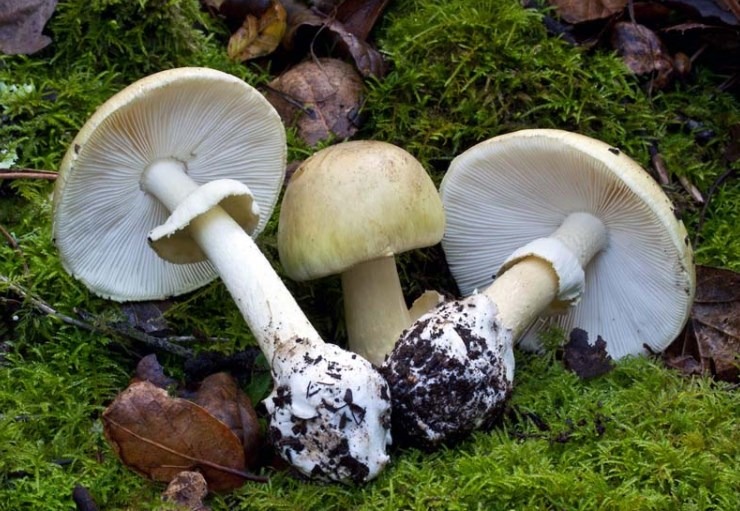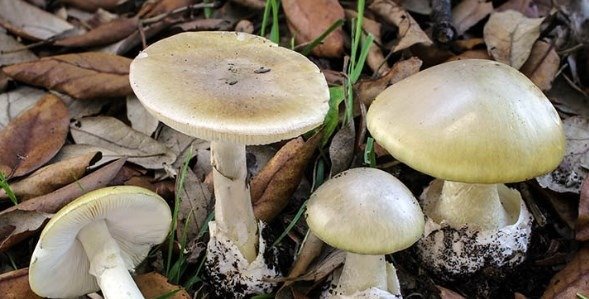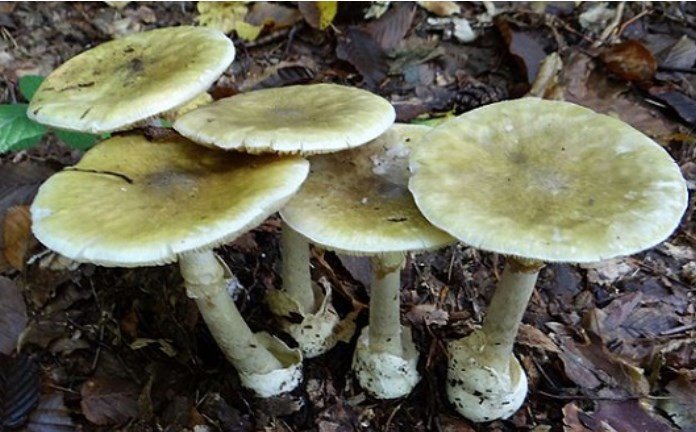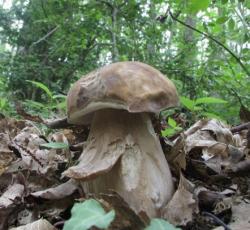The Amanita Phalloides or Death Cap Mushroom, is one of the most dangerous mushrooms that can be found in our regions and also in all of Europe. The ingestion of even small fragments of this fungus can be lethal. The danger is increased by the fact that the fungus is among the most common. Amanita Phalloides causes irreversible damage to the liver.
Problems and symptoms due to ingestion of Amanita Phalloides can be felt even 8 hours after ingestion. This depends largely on the physical constitution of the person who ate the fungus.

Indice
Names of Amanita Phalloides
Amanita Phalloides is commonly known as Death Cap. Other names are agaricus bulbosus, or fungus Amanita and Amanita Falloide in Italy.
Description of Amanita Phalloides
In the first stage of development of the fungus, the Amanita Phalloides is covered and wrapped by a white membrane. The membrane takes the form of an egg wider at the bottom than at the top. This white veil is consistent and solid.
Once developed, the cap of the Amanita Phalloides measures from 5 to 20 cm in diameter. Its shape is bell-shaped and then becomes convex and almost flat or perfectly stretched sometimes. Older specimens or those that have undergone bad weather will have slightly concave hats.
The colour of the cap is very variable and sometimes it can appear with colours ranging from yellow to green to olive green with many shades. Sometimes it can even be completely white.
Gills of Death Cap Mushrooms
The gills of the Death Cap mushroom are very different from each other, they are wide and interspersed with lamellulas. The colour of the gills of the ringworm fungus can vary from white to a light greenish yellow shade.
Stipe of Death Cap Mushrooms
The stipe of the Amanita Phalloides measures from 3 to 20 cm high with a thickness that varies from 3 mm to 3 cm. It has a cylindrical shape and is slightly thinner at the top. At the base the ringworm is bulbous.
In the newly developed fungi it is full and robust and, on the contrary, in the more adult specimens it can be even hollow. The colour of the stipe is white and sometimes it has greenish or yellowish brown knurls. The stem easily detaches from the Cap.
Ring
The ring of the fungus Amanita phalloides is located on its stipe, at the top and is usually very visible. It falls slightly downwards and the colour is white with yellowish shades.
Flesh
The flesh of the Death Cap Mushroom is white and slightly greenish tinged. The smell is almost absent in the young fungus but in the adult and mature fungus it is nauseous and fetid. This cadaveric odour is also perceived during the drying of the fungus. The flesh is tasteless and then becomes acidic and very fragile.

Habitat of Death Cap
The Amanita Phalloides Mushroom is a species of symbiotic fungus that grows continuously throughout the summer until the end of autumn. It is widespread throughout Europe and prefers deciduous forests, especially the grassy edges of the woods.
His favourite wood is oak and oak, as well as chestnut and hazelnut. It often grows next to the stumps of these species of trees.
Curiosities about Amanita Phalloides
This deadly fungus was certainly known from ancient times when alchemists or sorcerers used it to get rid of uncomfortable people and were careful not to spread the knowledge of this mushroom.
The lethal dose for the man ingesting the amanita phalloides is calculated in one gram per kg body weight. Much less in children and debilitated people. Even a few grams of pulp inadvertently placed in the pan can cause serious discomfort and damage to organs.
Even the mere fact of touching the Amanita Phalloide and putting it in the mushroom basket and then removing it again could have compromised all the other fungi as the spores of the amanita fungus could have fallen over the other edible mushrooms compromising their edibility. Unfortunately, the symptoms appear only after the liver is irreparably compromised.

Species to be confused with Amanita Phalloides
The Amanita Phalloides Mushroom has a cap colour and in general a colour variety that can deceive hasty collectors and endanger their lives.
Therefore, great care must be taken when picking mushrooms if one of these mushrooms is found. The Amanita Phalloides can be confused with the Agaricurs Silvicola and the Amanita Ovoidea which are both edible fungi. Also the Russula Virescens can be in some cases similar to the deadly Amanita Phalloides.
The advice is always to discard mushrooms of which you are not 100% sure of their edibility.
IDENTITY CARD
CAP COLOR: Olive tree
STIPE HEIGHT: 6-12 cm
STIPE COLOR:white
GILLS: White
FLESH: White
SMELL: Odourless when young
TASTE: acidulous
SPORES: white
HABITAT: Hardwoods
Did you find what you were looking for? See also here:
- Ganoderma Lucidum
- Armillaria Mellea
- Amanita Caesarea
- Agaricus Bisporus
- Amanita Phalloides
- Coriolus Versicolor
- Flammulin Velutipes
- Marasmius Oreades
- Pleurotus Ostreatus
- Agaricus Campestris
- Macrolepiota procera
